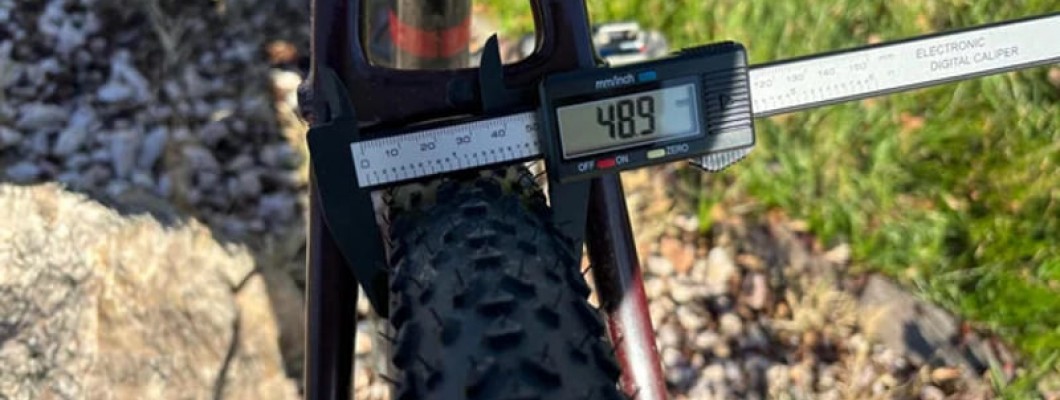
When gravel riding began its unstoppable rise, bikes were typically equipped with 35mm tires. Over time, the 700x40c specification gradually became the standard. But today, new models are designed to accommodate 45mm or even 50mm tires—often precisely what competitive riders demand. This trend extends beyond gravel, permeating road cycling as well, while mountain biking witnessed a similar evolution much earlier.
Why are wider gravel tires faster?
his phenomenon is particularly evident in mountain biking—where 2.4-inch-wide tires have long been commonplace in pure competitive disciplines like XCO Olympic cross-country, marathon cross-country, and short track. Road cycling has not escaped this tire-bulking trend either: the standard 700x23c tires of the early 2000s were successively replaced by 25mm and 28mm variants. Following Tadej Pogačar's use of 700x30c tires in last year's Tour de France, this specification is poised to become the new norm. Only cyclocross remains constrained by a 33mm rule limit.
Clearly, gravel riding couldn't remain untouched by this “tire bulking” movement, especially as lab tests validated what other disciplines had long confirmed: wider tires reduce rolling resistance, with particularly noticeable effects on rough terrain.
The Key Principle of Efficiency
The core mechanism driving efficiency gains with wider tires across disciplines is identical: minimizing energy loss during microseconds of pedaling force due to bouncing and momentary loss of contact caused by road irregularities.
Laboratory tests across different wheel sizes demonstrate that smaller-volume tires only hold an advantage on perfectly flat surfaces. In reality, even 29x2.2-inch mountain bike tires exhibit lower rolling resistance than common gravel tire specifications—the resistance difference between current 35mm all-terrain tires and mountain bike tires can reach up to 42 watts.
The Weight vs. Resistance Tradeoff
Conventional wisdom suggests wider tires suffer from added weight. However, the power increase required to drive this extra mass is far outweighed by the rolling resistance savings gained from increased tire volume. Moreover, wider tires don't necessitate overly reinforced casings; instead, they enable lighter construction and higher flexibility, further optimizing rolling performance.
Advantages Beyond Power Data
In typical gravel races, often covering ultra-long distances, wide tires offer another critical advantage: they significantly enhance riding comfort by supporting lower tire pressures without sacrificing rolling efficiency.
These benefits are widely acknowledged by gravel racers. The sight of elite riders uniformly opting for road bikes fitted with cyclocross tires at the inaugural Gravel World Championships may soon become a thing of the past. In fact, 700x45c to 700x50c tires have become standard race gear, with some riders even choosing XCO mountain bike tires for technically demanding courses.
The only unknown is where this “tire fattening competition” will end. Perhaps technology follows a cycle—if this trend continues, gravel bikes risk losing their versatile essence and ultimately retracing the development path of mountain bikes.


![[Ultralight] 390g 700C 50x36mm Symmetric Carbon Tubeless Gravel / CX Wheels Rim also for Beach Racers and their Demanding Sandy Terrain [Ultralight] 390g 700C 50x36mm Symmetric Carbon Tubeless Gravel / CX Wheels Rim also for Beach Racers and their Demanding Sandy Terrain](https://www.carbonbikekits.com/image/cache/catalog/Rim/Road/36mm/50x36/[Ultralight]-390g-700C-50x36mm-Symmetric-Carbon-Tubeless-Gravel-CX-Wheels-Rim-also-for-Beach-Racers-and-their-Demanding-Sandy-Terrain-250x250.jpg)
![[Ultralight] 390g 700C 50x36mm Symmetric Carbon Tubeless Gravel / CX Wheels Rim also for Beach Racers and their Demanding Sandy Terrain [Ultralight] 390g 700C 50x36mm Symmetric Carbon Tubeless Gravel / CX Wheels Rim also for Beach Racers and their Demanding Sandy Terrain](https://www.carbonbikekits.com/image/cache/catalog/Rim/Road/36mm/50x36/700C-50x31mm-Carbon-Tubeless-Hooked-Hookless-Gravel-CX-Rim-250x250.jpg)
![Flucircle [Ultralight] 380g 700C 47x40mm Carbon Tubeless Gravel / CX / MTB / Beach Racer Wheels Rim Flucircle [Ultralight] 380g 700C 47x40mm Carbon Tubeless Gravel / CX / MTB / Beach Racer Wheels Rim](https://www.carbonbikekits.com/image/cache/catalog/Rim/Road/40mm/Flucircle-[Ultralight]-380g-700C-47x40mm-Carbon-Tubeless-Gravel-CX-MTB-Beach-Racer-Wheels-Rim-250x250.jpg)
![Flucircle [Ultralight] 380g 700C 47x40mm Carbon Tubeless Gravel / CX / MTB / Beach Racer Wheels Rim Flucircle [Ultralight] 380g 700C 47x40mm Carbon Tubeless Gravel / CX / MTB / Beach Racer Wheels Rim](https://www.carbonbikekits.com/image/cache/catalog/Rim/Road/40mm/flucircle/Flucircle-[Ultralight]-380g-700C-47x40mm-Carbon-Tubeless-Gravel-CX-MTB-Beach-Racer-Wheels-Rim-1-250x250.jpg)


Leave a Comment